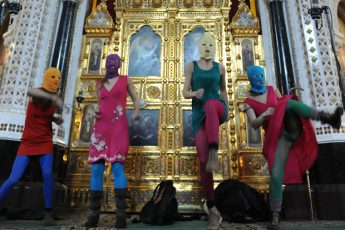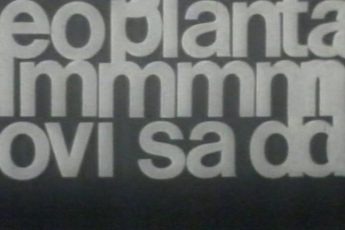Displacing the Revolution
Yuriy Hrytsyna’s Varta1 (2014) & Mykola Ridnyi’s Regular Places (2015)
Vol. 105 (May 2020) by Oleksiy Kuchansky
In the age of total marketing, info-wars and the dictatorship of media-panic, has representation now been reduced to a question of mere subjectivity? The development of skills that produce mass affect, such as digital advertising, along with the instrumentalization of the internet for the purposes of political propaganda, have already transformed and weakened the very term “representation” into a stream of naive musings. People no longer care as much about mediated sensationalist “current” events, as they do about media panic itself. Media moral panics have become one of the few forms of collective action for lonely hearts illuminated by their smartphone screens, whether they be the digital sub-domains of religious fundamentalists, ethno-nationalists, eco-warriors, or bedroom Communists.
The films Regular Places by Mykola Ridnyi and Varta1 by Yuriy Hrytsyna exempliyfy different ways of thinking about the Maidan Revolution in Ukraine (winter 2013 – spring 2014). The Maidan Revolution resulted from a popular uprising in the context of a crisis (financial and identity-driven) in Ukraine that was accelerated by social media as well as democratic and nationalist rhetoric on TV. This rhetoric emerged from both professional politicians and ordinary citizens. Faced with economic, political, and existential uncertainty, a rhetoric of national values appeared as a tool against rising instability.
However, what if uncertainty were employed as a technique for looking at the Maidan Revolution? Ridnyi and Hrytsyna have done just that, placing notions of instability and uncertainty at the heart of their artistic methods. Within the given media-environment, this essay not only addresses the representational capacity of these two Ukrainian films, but will also take into account the process of “representing” as an aspect of their infrastructure. Thus the expression of political instability, conveyed in the form of opacity in these films, can be studied as a form of artistic and political action. These films are not concerned with representation as-is, but rather rely on a deliberately opaque presentation of events to direct the viewer to reflect on how meaning is produced. This essay will therefore approach the manner in which the films produce their own referents, emerging as types of enunciation, and will attempt to explore the effects of this production.
“Varta1” by Yuriy Hrytsyna
Varta1 is narrated by the non-diegetic, authentic recordings of the walkie-talkie chatter between the members of a self-organized activist network that emerged in Lviv at the end of the Maidan, at a moment when the established municipal government had been overthrown and a new one had not yet replaced it. Those activists performed law enforcement functions and replaced the dethroned city police. Guided by recordings of the walkie-talkie conversations, Hrytsyna has created a video-reconstruction aiming to evoke the collective experience of that time. These audio records chronicle the activists’ efforts at self-organization, their ideas on revolution and their political imagination of the future, overlaid with VHS images of meditative landscapes and the mundane spaces of Lviv.
Hrystyna’s film pointedly provokes several questions. Why did the director avoid recognizable images of the city, opting to depict the lesser-known periphery instead? Why has he chosen to shoot on VHS, a long-outdated video format? What is the significance of the discrepancy between these audio and visual records?
The typical well-worn analogy for revolution tends to imagine it as the turning of a page. Revolution is supposed to be the mechanism by which a society can restart its political or economic life from scratch – a deliberate shift. Varta1 offers a radically different train of thought, imagining revolution as a collective displacement. Displacement is a change in everyday life; it occurs perforce rather than with intention. Turning the page back again becomes impossible. The concept of displacement runs contrary to the accepted wisdom, one that ignores the revolutionary tendency to reestablish repressive political structures through the use and abuse of a universalist moral agenda. To this extent, Hrytsyna’s use of VHS footage and deliberate regard away from the center of activity serves to reflect this idea on an aesthetic plane: unexpected images are, here, filmic gestures of displacement. Hrystyna thus shuns a mass-media mode of representation for a visual style that hinges on the very factual disposition of forces with its very specific possibilities, instead of a universal “as it has to be”.1
The visual mode of the video is not the only strategy being used to redefine revolution and its mediatic representation: the content of the walkie-talkie recordings in Varta1, rife with the internal conflicts between activists and their opponents, also serves this purpose. Most of the film chronicles activists as they deal with day-to-day patrols on the streets of Lviv, safeguarding public spaces against looters and violent counterrevolutionaries. Occasionally the activists assume the specific role of the police, as when they pursue a speeding red Porsche Cayenne and discuss the best route to head it off. The dialogue is chaotic and incomprehensible. Suddenly, an argument breaks out: some activists are enraged by this luxurious red car, perceived as a symbol of the social privilege of the previous social order. The Porsche’s infraction was insignificant, however. In the audio recording of the pursuit, we can observe all the ambiguities and fluidities of the structural inequalities of both the old and new social orders.
Yuriy Hrytsyna neither condemns the activists for their political views nor does he judge the (in)effectiveness of their actions. Varta1 makes no attempt to claim Maidan as a world-upheaval, but rather as an opening that leaves much work to be accomplished, with nascent self-organization and unaddressed underlying xenophobia. The displacements at stake in the restructuring of the everyday (political, economic, communicative, aesthetic) preclude the film from representing the Maidan as a sensationalist media event. Like the aesthetic approach of Hrytsyna’s film itself, the revolution may only bring about change by recycling ordinary practices and micro-practices.
“Regular Places” by Mykola Ridnyi
Regular Places represents the violence that took place between Maidan and Antimaidan activists.2 Like Varta1, it is concerned with the everyday: it depicts ordinary citizens of Kharkiv taking walks in five different public locations. The images of these seemingly banal public squares are accompanied by audio recordings of the violent conflicts between the aforementioned activists, culled from videos posted to social networks, documenting conflicts in the same locations shown on screen. Like Varta1, the audio and visual records of this film are in discord, to extremely violent effect: shouts of threats, abuse and alarm echo over images of the tranquil cityscape of Kharkiv.
The artist claims that the film depicts violence in a manner explicitly contrary to that of mass-media, by denying the viewer the pleasure of watching.3 Viewers cannot see the source of danger, and are thus deprived of the voyeuristic pleasure of observing without being implicated.
Though Ridnyi perhaps fails in making a film that is not entertaining to watch, it does indeed distort the viewer’s knowledge of the source of violence. Political philosopher Maurizio Lazzarato states that mass media don’t produce messages, but a world or a universe unto itself: a variety of signs – images, statements and rhythms – used to institute and maintain dominant political and economic norms.4 Mass media use the same signifiers and images over and over again, in a consumerist process where the reality of the “event” is no longer represented, but where the possibility for difference is produced – as in an eschatological mode. In the incessant flux of images, signs and statements, the subject of history is reduced to a simple conclusion: new possibilities can emerge towards a liberation from fatal struggles. As Lazzarato states, it “doubles the world and our existence as ‘something possible’, which is, in fact, already a command, an authoritarian slogan expressing itself through seduction.”5
This is exactly what I mean by media panics: the consumption of ideology, not only in discourse but also in lifestyle, whether liberal, progressive, nationalist or familialist. They are constituted by specific colors (from the nationalist’s flag to the capitalist TV pundit’s pearly whites) and sounds (anthems or catch-phrases), producing their own corporeal and existential universes. Ridnyi’s film thus hinges on much more than a simple denial of voyeuristic pleasure; it shuns the consumerist ‘representation’ of violence, and in turn draws the viewer to the ideological events sustaining it.
Nevertheless Ridnyi’s work is more than a simple condemnation of the ideological mechanisms of the media. In compositing the everyday landscape of Kharkiv and the violent sounds of the revolution period, the director breaks up the dichotomy of the Ukrainian nationalists on the one hand and the Russian recidivists on the other, splitting them into shards, mixing them together and separating them from their visual referents.
In a way, Regular Places can be likened to a film of flashbacks, cinematically coded through the denial of visual content. Watching the film, one has the impression of standing in the street in a fog of delirium, listening to something that reverberates from the past. This “flashback” technique presents the viewer with an experience of violence that hasn’t found its place in any recognizable heroic frame of reference (liberal-emancipative, nationalistic or marxist-democratic). The effect is one of displacement, similar to that of Varta1, leading the viewer away from the “reality” of the event. What makes the “flashback” particularly effective here is the way the events presented are at once happening and not happening. On the one hand, the event is tangibly distant; on the other, the sensations provoked are very real, and in that way the event becomes material once again.
Nevertheless, the static camera of Regular Places confers a sort of meta-stability on this otherwise disturbed emotional and temporal plane. Which kind of stability is it? How does this affect the discord in the film’s temporality? Not knowing the source of danger, the viewer gropes for context, and in doing so may grow more involved in the process than suggested by the dissonant audio-documentation. The result is one of involved distance: watching, imagining, remembering and reinventing the political situation are ways of becoming courageous enough to understand without sacrificing uncertainty.
Varta1 and Regular Places both reflect on the Maidan Revolution through the lens of media representation. Both films turn away from the representational modes of mass media, instead concentrating on aspects of uncertainty, opacity and displacement. The repurposing of found audio, and the discord of the paired images, draws attention to the processes by which the event at the center of these films is constituted, sustained and consumed, while effectively avoiding the ideological mechanisms of media representation. Thus, neither film stands as the explicit product of any one dominant political universe (the pro-inclusive one in Varta1’s case and the anti-nationalist one in Regular Places). That is what I have termed displacement: the method of reordering the constituent parts to produce a state of mediative reflexivity, an involved distance, that displays what micro-revolutionary courage is.
Courage should not always be modeled as a heroic action; it can be seen as an ordinary virtue. To be courageous is not the same as to be heroic, in the sense of the extraordinary, necessary heroic endeavor. Having the bravery to make microscale, sometimes thriveless, half-blind yet radical steps should be understood as the real revolutionary act, instead of the epic fight for values that are already lost. The significance of Varta1 and Regular Places is inventing the filmic universes of such non-heroic, ordinary acts of courage as remembering the limits of your knowledge, recognizing the relativity of failure, and overcoming the fear of otherness. In other words, by reevaluating the obvious and staying open to the irregularity of regular places, the films present a thousand uncertain micro-revolutions in lieu of the Last Great One – one that will never happen.
References
- 1.This can be compared to Donna Haraway’s non-essentialist revision of ecology. There is no way to start from scratch, just as there is no way not to mention the events which return after revolution. See Haraway, D. J. (2016). Staying with the trouble: Making kin in the Chthulucene. Duke University Press.
- 2.Antimaidan is a counter-Maidan by pro-Russian conservative activists who were mostly mobilized by the pre-revolutionary government.
- 3.Statement given in an unrecorded private conversation with the author.
- 4.Lazzarato (2003) Struggle, Event, Media. Republic Art. URL: http://republicart.net/disc/representations/lazzarato01_en.htm [Accessed on June 7th 2020].
- 5.Ibid.




Leave a Comment